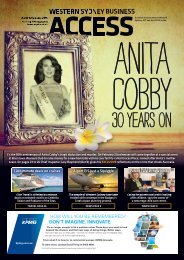RECRUITMENT
WSBA September 2015
WSBA September 2015
Create successful ePaper yourself
Turn your PDF publications into a flip-book with our unique Google optimized e-Paper software.
INDIAAUSTRALIA<br />
Business Connect<br />
WWW.WSBA.COM.AU<br />
How A R Rahman brought Bollywood<br />
soundtracks to the Western world<br />
CULTURE<br />
By Anna Morcom<br />
Reader in Ethnomusicology at Royal Holloway<br />
WITH record sales of more than 200<br />
million albums worldwide, A R Rahman<br />
has composed the soundtracks<br />
for over 100 Indian films and is credited<br />
with more or less single-handedly revolutionising<br />
Indian film musi c.<br />
On August 15 Rahman will be performing<br />
a one-off “Greatest Hits” show at The O2 arena<br />
in London. He has brought Bollywood music<br />
to the Western world, with a style that is both<br />
new and familiar at the same time.<br />
The son of a film music composer and<br />
conductor in the Tamil and Malayalan film<br />
music industries, Allah-Rakha Rahman got his<br />
big break as a music director doing the songs<br />
and background score for the Tamil film Roja.<br />
In India, film music reigns supreme, and Rahman’s<br />
soundtrack took the country by storm.<br />
A R Rahman recording with fellow artist Orianthi Sreejithk.<br />
Bollywood on tour<br />
India has produced many giants of film<br />
music. But the key difference with Rahman,<br />
compared to earlier star music directors such<br />
as Naushad, Shankar-Jaikishen, R D Burman or<br />
Ilaiyaraaja, is the level of international acclaim<br />
he has gained. It is Rahman’s conquering of the<br />
Western world that makes him so remarkable.<br />
By the 1950s, Indian cinematic music had<br />
a dominant influence from the Malay world<br />
to Greece, Russia, and the Middle East. In the<br />
West, however, Hollywood held sway, and<br />
Indian cinema, with its melodrama and song<br />
and dance interludes, was typically seen simply<br />
as bad.<br />
The new sounds and style Rahman created<br />
changed the image of Indian film music in the<br />
West. His albums broke through into Western<br />
charts in the late 1990s and he has since engaged<br />
in a range of high profile collaborations<br />
in the West.<br />
His most famous work of late has been<br />
his soundtrack for Danny Boyle’s 2009 film<br />
Slumdog Millionaire, which added two Oscars,<br />
a BAFTA, a Golden Globe Award and two<br />
Grammy Awards to his already dizzying array<br />
of awards back home in India. As an Indian<br />
music star in the West, he has only been rivalled<br />
by the likes of Ravi Shankar.<br />
AR Rahman’s ‘Jai Ho’ from the 2009 film<br />
Slumdog Millionaire<br />
New fusions<br />
Rahman’s acclaim is largely down to his<br />
use of fusion. East-West fusion is hardly new<br />
in Indian film music – by the 1950s, film songs<br />
sported extraordinary mixtures of Indian classical<br />
and folk music elements, large Western or<br />
Hollywood style orchestras with added Indian<br />
instruments, and global pop styles from the<br />
West and Latin America. Yet Rahman’s fusion<br />
marks a distinct break with earlier film music.<br />
He is particularly known for his use of lush<br />
string sounds, often married with computergenerated<br />
bass.<br />
Overall, his timbres are more mellifluous<br />
and soft compared to the older film music,<br />
where treble frequencies dominated.<br />
New recording technologies have allowed<br />
Rahman to create a layered and expansive<br />
soundscape, contrasting with earlier film music<br />
where the orchestras were recorded in unison<br />
or near unison, the sound more of a block.<br />
In older film music, Indian and western<br />
instruments and styles were orchestrated into a<br />
whole, a close amalgamation. T<br />
he violins, for example, hardly sounded like<br />
those in a Western orchestra, or the sitars like<br />
those in actual Indian classical music.<br />
This is part of the reason why the older film<br />
songs were seen in negative terms by Western<br />
critics as kitsch. But in Rahman’s music, the<br />
characteristic style and sound of diverse instruments<br />
and genres is distinctly heard, and often<br />
showcased.<br />
In the song Hai Rama from the film Rangeela<br />
(1995), for example, he opens and ends<br />
the song with the sound of the tambura, the<br />
drone instrument used to accompany Indian<br />
classical music.<br />
The song also incorporates South Indian<br />
and other percussion, strings, bass, and a<br />
virtuosic flute solo that manages to be Indian<br />
classical, beat box and slightly jazzy all at once.<br />
In other songs Rahman uses Sufi singing,<br />
or the harmonium (played as in North Indian<br />
classical or light classical music), or background<br />
chants in regional Indian languages,<br />
and an assortment of other Indian styles and<br />
instruments.<br />
His music appeals to the “world music”<br />
and “world beat” sensibility that is growing in<br />
popularity in the West.<br />
At the same time, Rahman incorporates a<br />
solid basis of mainstream Western pop, rock<br />
and jazz styles (even just through a prominent<br />
bass groove).<br />
He uses a range of singers and vocal<br />
timbres, avoiding the idealised, high-pitched female<br />
vocal sound. For these reasons, Rahman’s<br />
music appeals to western ears more than older<br />
film music, and also to the upper end of Indian<br />
middle class society.<br />
THIS ARTICLE WAS FIRST PUBLISHED AT WWW.THECONVERSATION.COM.AU<br />
New sports bar at Maharaja’s Haveli<br />
ATTRACTIONS<br />
IF you thought Maharaja’s Haveli only offered<br />
the best regional Indian Cuisine around,<br />
you’re wrong.<br />
Regular patrons would have recently<br />
witnessed a new bar emerging in the Haveli<br />
Vedah next to the famous Punjab Truck.<br />
Maharaja’s Bar is fully stocked with all the<br />
best liquors and beers beautifully featured in<br />
oversized bottles.<br />
Maharaja’s Bar has been thoughtfully<br />
furnished providing comfort in the form<br />
of leather lounge chairs and allowing close<br />
mingling and laughter around high tables and<br />
bar stools.<br />
A striking portrait of Maharaja Ranjit<br />
Singh adorns the wall opposite the bar and beside<br />
it a collection<br />
of glasses dating<br />
back centuries. As<br />
with the rest of the<br />
Haveli, Maharaja’s<br />
Bar is befitting of<br />
a king.<br />
Maharaja’s<br />
Haveli is the ideal<br />
place to join in<br />
drinks with friends<br />
and enjoy the excitement<br />
of a footy<br />
match whether<br />
it’s AFL, league<br />
or union, cricket,<br />
Ashes or soccer<br />
from around the<br />
world or any other<br />
big sporting event on the big screen.<br />
Watch all the action of the Rugby World<br />
Cup and the finals of the footy season at the<br />
new Maharaja’s Sports Bar.<br />
SPECIAL FOR THE MONTH OF SEP-<br />
TEMBER: Buy one drink get another free,<br />
available with the latest bar menu - kebabs<br />
and snacks.<br />
38 WESTERN SYDNEY BUSINESS ACCESS SEPTEMBER 2015






